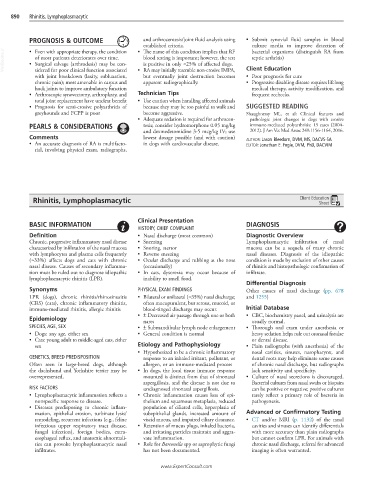Page 1770 - Cote clinical veterinary advisor dogs and cats 4th
P. 1770
890 Rhinitis, Lymphoplasmacytic
PROGNOSIS & OUTCOME and arthrocentesis/joint fluid analysis using • Submit synovial fluid samples in blood
established criteria. culture media to improve detection of
VetBooks.ir • Surgical salvage (arthrodesis) may be con- blood testing is important; however, the test Client Education
bacterial organisms (distinguish RA from
• The name of this condition implies that RF
• Even with appropriate therapy, the condition
septic arthritis)
of most patients deteriorates over time.
is positive in only ≈25% of affected dogs.
sidered for poor clinical function associated
with joint breakdown (laxity, subluxation, • RA may initially resemble non-erosive IMPA, • Poor prognosis for cure
but eventually joint destruction becomes
chronic pain); most amenable in carpus and apparent radiographically. • Progressive disabling disease requires lifelong
hock joints to improve ambulatory function medical therapy, activity modification, and
• Arthroscopic synovectomy, arthroplasty, and Technician Tips frequent rechecks.
total joint replacement have unclear benefit • Use caution when handling affected animals
• Prognosis for semi-erosive polyarthritis of because they may be too painful to walk and SUGGESTED READING
greyhounds and FCPP is poor become aggressive. Shaughnessy ML, et al: Clinical features and
• Adequate sedation is required for arthrocen- pathologic joint changes in dogs with erosive
PEARLS & CONSIDERATIONS tesis; consider hydromorphone 0.05 mg/kg immune-mediated polyarthritis: 13 cases (2004-
and dexmedetomidine 3-5 mcg/kg IV; use 2012). J Am Vet Med Assoc 249:1156-1164, 2016.
Comments lowest dosage possible (and with caution) AUTHOR: Jason Bleedorn, DVM, MS, DACVS-SA
• An accurate diagnosis of RA is multifacto- in dogs with cardiovascular disease. EDITOR: Jonathan E. Fogle, DVM, PhD, DACVIM
rial, involving physical exam, radiographs,
Rhinitis, Lymphoplasmacytic Client Education
Sheet
Clinical Presentation
BASIC INFORMATION DIAGNOSIS
HISTORY, CHIEF COMPLAINT
Definition • Nasal discharge (most common) Diagnostic Overview
Chronic, progressive inflammatory nasal disease • Sneezing Lymphoplasmacytic infiltration of nasal
characterized by infiltration of the nasal mucosa • Snoring, stertor mucosa can be a sequela of many chronic
with lymphocytes and plasma cells frequently • Reverse sneezing nasal diseases. Diagnosis of the idiopathic
(≈33%) affects dogs and cats with chronic • Ocular discharge and rubbing at the nose condition is made by exclusion of other causes
nasal disease. Causes of secondary inflamma- (occasionally) of rhinitis and histopathologic confirmation of
tion must be ruled out to diagnose idiopathic • In cats, dysorexia may occur because of infiltrate.
lymphoplasmacytic rhinitis (LPR). inability to smell food.
Differential Diagnosis
Synonyms PHYSICAL EXAM FINDINGS Other causes of nasal discharge (pp. 678
LPR (dogs), chronic rhinitis/rhinosinusitis • Bilateral or unilateral (≈35%) nasal discharge; and 1255)
(CRS) (cats), chronic inflammatory rhinitis, often mucopurulent, but serous, mucoid, or
immune-mediated rhinitis, allergic rhinitis blood-tinged discharge may occur. Initial Database
• ± Decreased air passage through one or both • CBC, biochemistry panel, and urinalysis are
Epidemiology nares usually normal.
SPECIES, AGE, SEX • ± Submandibular lymph node enlargement • Thorough oral exam under anesthesia or
• Dogs: any age, either sex • General condition is normal heavy sedation helps rule out oronasal fistulae
• Cats: young adult to middle-aged cats, either or dental disease.
sex Etiology and Pathophysiology • Plain radiographs (with anesthesia) of the
• Hypothesized to be a chronic inflammatory nasal cavities, sinuses, nasopharynx, and
GENETICS, BREED PREDISPOSITION response to an inhaled irritant, pollutant, or dental roots may help eliminate some causes
Often seen in large-breed dogs, although allergen, or an immune-mediated process of chronic nasal discharge, but radiographs
the dachshund and Yorkshire terrier may be • In dogs, the local tissue immune response lack sensitivity and specificity.
overrepresented. mounted is distinct from that of sinonasal • Culture of nasal secretions is discouraged.
aspergillosis, and the disease is not due to Bacterial cultures from nasal swabs or biopsies
RISK FACTORS undiagnosed sinonasal aspergillosis. can be positive or negative; positive cultures
• Lymphoplasmacytic inflammation reflects a • Chronic inflammation causes loss of epi- rarely reflect a primary role of bacteria in
nonspecific response to disease. thelium and squamous metaplasia, reduced pathogenesis.
• Diseases predisposing to chronic inflam- population of ciliated cells, hyperplasia of
mation, epithelial erosion, turbinate lysis/ subepithelial glands, increased amount of Advanced or Confirmatory Testing
remodeling, recurrent infections (e.g., feline viscid mucus, and impaired ciliary clearance. • CT and/or MRI (p. 1132) of the nasal
infectious upper respiratory tract disease, • Retention of mucus plugs, inhaled bacteria, cavities and sinuses can identify differentials
fungal infection), foreign bodies, extra- and irritating particles maintain and aggra- with more accuracy than plain radiographs
esophageal reflux, and anatomic abnormali- vate inflammation. but cannot confirm LPR. For animals with
ties can provoke lymphoplasmacytic nasal • Role for Bartonella spp or saprophytic fungi chronic nasal discharge, referral for advanced
infiltrates. has not been documented. imaging is often warranted.
www.ExpertConsult.com

